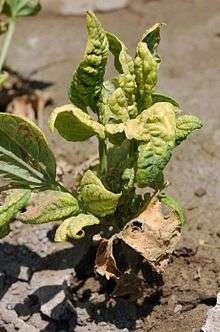Curly top

Curly top is a viral disease that affects many crops. This disease causes plants to become smaller in size, have shriveled petals and leaves, and are twisted and pulled out of shape. They are often caused by curtoviruses (genus Curtovirus), members of the virus family Geminiviridae. This disease is important in western United States, such as California, Utah, Washington, and Idaho.
Curly top is characterized by stunting of the plant and deformation of leaves and fruit. The petioles and blades of the leaves curl, twist, and become discolored.[1]
- Beet curly top virus causes curly top disease in beets and is carried by the beet leafhopper. The term curly top virus often refers to this specific virus.[1] It can also cause curly top in tomatoes, beans, cucurbits, and other crops.[2] This disease can be reduced if plants are planted in the shade because the beet leafhoppers and other insects like to feed on these plants in the sun.
- Curly top disease in spinach can be caused by the beet curly top virus, the pepper curly top virus,[3] or the recently described spinach curly top virus.[4]
- Other curly top curtoviruses include beet severe curly top virus, beet mild curly top virus, and horseradish curly top virus.[4] The newly discovered turnip curly top virus may also be a species of curtovirus.[5]
Common carriers
The most common plants to carry the curly virus are beets, tomatoes, spinach, peppers, beans, potatoes, cucurbits, many ornamentals, and weeds such as Russian thistle (tumbleweed) and mustard. [6] These are not the only plants to carry this, in fact, a total of 44 plant families and 300 species[7] are susceptible to it. [8] Sugar beets are the most common carriers of the disease, for which the alternative name of the disease, beet curly top virus (BCTV), is derived from. [9]
Transmission
Curly top virus is transmitted by the sugar beet leafhopper (Curculifer tennelus)[10] throughout arid and semi-arid locations. [11]
References
- 1 2 Goldberg, N. P. Curly Top Virus. Guide H-106. College of Agriculture, Consumer and Environmental Sciences. New Mexico State University.
- ↑ Curly Top Disease of Tomato. Entomology and Plant Pathology. Oklahoma State University.
- ↑ Diseases of spinach (Spinacia oleracea) in Arizona. Arizona Extension Plant Pathology.
- 1 2 Baliji, S., et al. (2004). Spinach curly top virus: A newly described curtovirus species from southwest Texas with incongruent gene phylogenies. Phytopathology 94(7) 772-79.
- ↑ Briddon, R. W., et al. (2010). Turnip curly top virus, a highly divergent geminivirus infecting turnip in Iran. Virus Research 152(1–2) 169–75.
- ↑ http://aces.nmsu.edu/pubs/_h/H106/
- ↑ http://aces.nmsu.edu/pubs/_h/H106/
- ↑ https://www.gardeningknowhow.com/edible/vegetables/tomato/treating-curly-top-virus.htm
- ↑ http://aces.nmsu.edu/pubs/_h/H106/
- ↑ http://plantdiseasehandbook.tamu.edu/problems-treatments/problems-affecting-multiple-crops/curly-top-virus/
- ↑ http://aces.nmsu.edu/pubs/_h/H106/